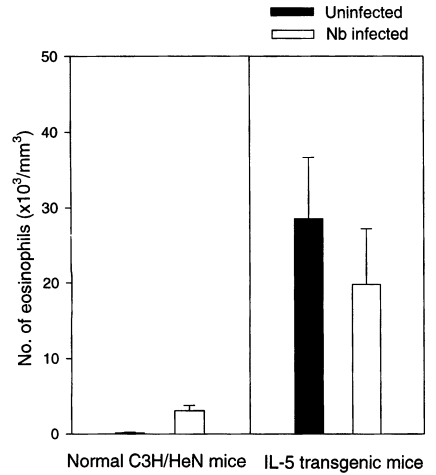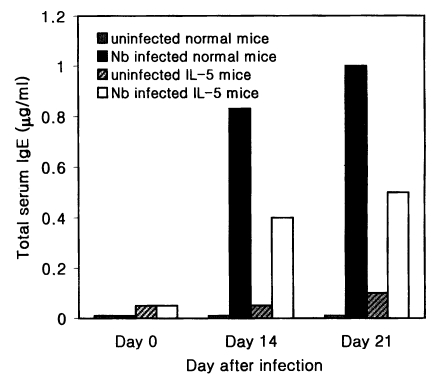1. Abe T, Sugaya H, Yoshimura K. Different susceptibility to the IL-3 induced protective effects between
Strongyloides ratti and
Nippostrongylus brasiliensis in C57BL/6 mice.
Parasite Immunol 1993;15:643-645.


2. Abe T, Sugaya H, Yoshimura K, Nawa Y. Induction of the expulsion of
Strongyloides ratti and retention of
Nippostrongylus brasiliensis in athymic nude mice by repeatitive administration of recombinant interleukin-3.
Immunology 1992;76:10-14.


3. Beaver PC, Jung RC, Cupp EW. Clinical Parasitology. 1984, 9th ed. Philadelphia, USA. Lea & Febiger. pp 162-167.
4. Capron M, Bazin H, Joseph M, Capron A. Evidence for IgE-dependent cytotoxicity by rat eosinophils.
J Immunol 1981;126:1764-1768.

5. Chen XJ, Wiedermann U, Dahlgren U, Hanson LA, Enerback L. T-cell-independent and T-cell-dependent IgE responses to the nematode
Nippostrongylus brasiliensis: comparison of serum IgE and mast-cell-bound IgE.
Immunology 1995;86:351-355.


6. Coffman RL, Seymour BWP, Hudak S, Jackson J, Rennick D. Antibody to interleukin-5 inhibits helminth-induced eosinophilia in mice.
Science 1989;245:308-310.


7. Dent LA, Munro GH, Piper KP, et al. Eosinophilic interleukin 5 (IL-5) transgenic mice: eosinophil activity and impaired clearance of
Schistosoma mansoni.
Parasite Immunol 1997;19:291-300.

8. Gounni AS, Lamkhioued B, Ochiai K, et al. High-affinity IgE receptor on eosinophils is involved in defence against parasites.
Nature 1994;367:183-186.


9. Hokibara S, Takamoto M, Tominaga A, Takatsu K, Sugane K. Marked eosinophilia in interleukin-5 transgenic mice fails to prevent
Trichinella spiralis infection.
J Parasitol 1997;83:1186-1189.

10. Kojima S, Ovary Z. Effect of
Nippostrongylus brasiliensis infection on anti-hapten IgE antibody response in the mouse I. Induction of carrier specific helper cells.
Cell Immunol 1975a;15:274-286.

11. Kojima S, Ovary Z. Effect of
Nippostrongylus brasiliensis infection on anti-hapten IgE antibody response in the mouse II. Mechanism of potentiation of the IgE antibody response to a heterologous hapten-carrier conjugate.
Cell Immunol 1975b;17:383-391.

12. Kojima S, Ovary Z. Carrier effect by
Nippostrongylus brasiliensis infection on rat antihapten IgE antibody response.
Int Arch Allergy Appl Immunol 1976;50:81-86.


13. Rennick DM, Thompsom-Snipes L, Coffmann RL, Seymour BWP, Jackson JD, Hudak S. In vivo administration of antibody to interleukin-5 inhibits increased generation of eosinophils and their progenitors in bone marrow of parasitized mice.
Blood 1990;76:312-316.


14. Shin EH, Osada Y, Chai JY, Matsumoto N, Takatsu K, Kojima S. Protective roles of eosinophils in
Nippostrongylus brasiliensis infection.
Int Arch Allergy Immunol 1997;114(suppl.):45-50.


15. Sugane K, Kusama Y, Takamoto M, Tominaga A, Takatsu K. Eosinophilia, IL-5 level and recovery of larvae in IL-5 transgenic mice infected with
Toxocara canis.
J Helminthol 1996;70:153-158.


16. Sugaya H, Aoki M, Yoshida T, Takatsu K, Yoshimura K. Eosinophilia and intracranial worm recovery in interleukin-5 transgenic and interleukin-5 receptor alpha chain-knockout mice infected with
Angiostrongylus cantonensis.
Parasitol Res 1997;83:583-590.


17. Takamoto M, Kusama Y, Takatsu K, Nariuchi H, Sugane K. Occurrence of interleukin-5 production by CD4-CD8- (double-negative) T cells in lungs of both normal and congenitally athymic nude mice infected with Toxocara canis. Immunology 1994;85:285-291.
18. Takatsu K, Takaki S, Hitoshi Y. Interleukin-5 and its receptor system: implications in the immune system and inflammation.
Adv Immunol 1994;57:145-190.


19. Takatsu K, Tominaga A, Harada N, et al. T-cell replacing factor (TRF)/interleukin-5 (IL-5): molecular and functional properties.
Immunol Rev 1988;102:107-135.

20. Tominaga A, Hitoshi Y, Takatsu K. Possible role of IL-5 ligand-receptor system in eosinophilia. T-Lymphocyte and Inflammatory Cell Research in Asthma. 1993, New York, USA. Academic Press. pp 87-103.
21. Tominaga A, Takasi S, Koyama N, et al. Transgenic mice expressing a B cell growth and differentiation factor gene (interleukin 5) develop eosinophilia and autoantibody production.
J Exp Med 1991;173:429-437.



22. Uchikawa R, Yamada M, Matsuda S, Kuroda A, Arizono N. IgE antibody production is associated with suppressed interferon-γ levels in mesenteric lymph nodes of rats infected with the nematode
Nippostrongylus brasiliensis.
Immunology 1994;82:427-432.


23. Urban JF Jr, Noben-Trauth N, Donaldson DD, et al. IL-13, IL-4Ralpha, and Stat6 are required for the expulsion of the gastrointestinal nematode parasite
Nippostrongylus brasiliensis.
Immunity 1998;8:255-264.


24. Watanabe N, Katakura K, Kobayashi A, Okumura K, Ovary Z. Protective immunity and eosinophilia in IgE-deficient SJA/9 mice infected with
Nippostrongylus brasiliensis.
Proc Natl Acad Sci USA 1988;85:4460-4462.








